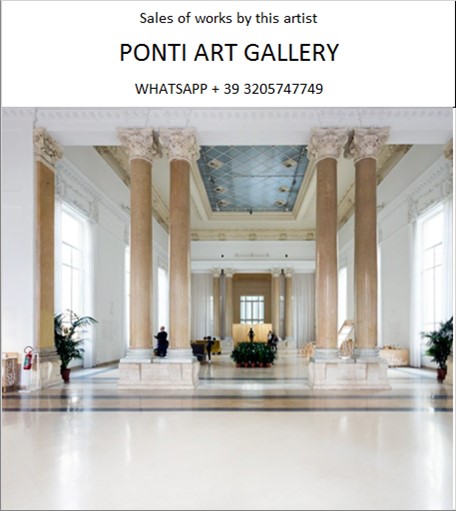Ponti Art Gallery is interested in buying and selling works
of art by this artist.

Max Weiler Biography
Max Weiler was born on August 27, 1910, in Absam, a small town near Hall in Tyrol, Austria, into the family of Dr. Max Weiler and Margaretha Maria. His early life in the picturesque landscapes of Tyrol deeply influenced his artistic sensibilities and his profound connection to nature. Weiler's education began at the Franciscan gymnasiums in Mehrau near Bregenz and Hall in Tyrol, laying the groundwork for his spiritual and intellectual development.
In 1930, Weiler's artistic journey took a significant turn when he was admitted to the Academy of Visual Arts in Vienna. There, under the tutelage of Professor Karl Sterrer, he not only honed his skills in painting but also encountered the ancient Chinese landscape art of the Sung Dynasty (960-1279). This exposure would leave a lasting impact on his artistic style, introducing him to concepts of nature and spirituality that would permeate his work throughout his career.
Weiler's early career was marked by a variety of projects, including his collaboration in 1936 with Clemens Holzmeister for the decoration of the Austrian chapel in the papal pavilion at the 1937 World Exposition in Paris. Here, he created the glass window "Bund im Blut des Sohnes." His work during this period was characterized by a blend of traditional and innovative elements, as seen in his controversial frescoes painted in 1945 at the Hungerburg in Innsbruck, which depicted people in traditional Tyrolean costume at the crucifixion of Jesus Christ.
The 1950s marked a significant shift in Weiler's artistic direction as he moved away from object representation towards abstract compositions. This transition was further solidified when he represented Austria at the XXX Venice Biennale in 1960, a year after being awarded the Grand Austrian State Prize. From 1964 to 1981, Weiler shared his knowledge and passion for art as a professor at the Academy of Graphic Arts in Vienna.
Throughout his career, Weiler's work was deeply influenced by the painters of the Sung Dynasty, with whom he shared a belief in the intertwining of nature and spirituality. His art evolved independently of contemporary movements, characterized by constant experimentation and a quest for understanding the essence of art. Weiler's diaries, the Tag- und Nachtheften (The Day and Night Notebook), reveal his introspective nature and his lifelong pursuit of capturing the spiritual essence of nature through his paintings.
Weiler's technique underwent a significant transformation around 1950 when he abandoned oil paints in favor of tempera, allowing for a more fluid and transparent application of color. This technical shift enabled him to explore the dynamic interplay between abstraction and figuration, creating artworks that resonated with the vibrancy and energy of nature without directly mimicking it.
Max Weiler's contributions to art were recognized with numerous awards and honors, including the Grand Austrian State Prize for Fine Arts (1960), the Austrian Decoration for Science and Art (1979), and the Grand Gold Medal with Star for Services to the Republic of Austria (2000). He became an honorary citizen of Vienna in 2000, a testament to his impact on the cultural landscape of Austria.
Weiler's legacy is preserved through his extensive body of work, which includes paintings, frescoes, mosaics, and glass paintings. His art continues to be celebrated in exhibitions worldwide, affirming his status as one of the most important Austrian painters of the 20th century. Max Weiler passed away on January 29, 2001, in Vienna, leaving behind a rich artistic heritage that continues to inspire and captivate audiences around the world.
Max Weiler Quotes and Sales of
Works
Ponti Art Gallery selects and deals with paintings by the
artist. Upon request, we provide free estimates and
evaluations, communicate prices, quotations, and current
market values.
If you are interested in BUYING or SELLING works by the
artist, contact us immediately.
If you wish to sell or receive an evaluation of the
works:
Send us a frontal photo of the painting, one of the back,
and one of the signature. Also, indicate the dimensions of
the work. Inform us about the purchase origin of the work
and any kind of available documentation (purchase
receipts, certificates of authenticity, publications). One
of our operators will respond to you on the same day. We
guarantee maximum confidentiality and extreme
professionalism.
If you wish to purchase works by the painter: Contact us
and let us know your request. We will inform you about the
available works. We also offer the possibility to
subscribe to our NEWSLETTER, through which you will be
informed at the beginning of each month about the latest
acquisitions of the art gallery.
You can send us pictures of the work:
